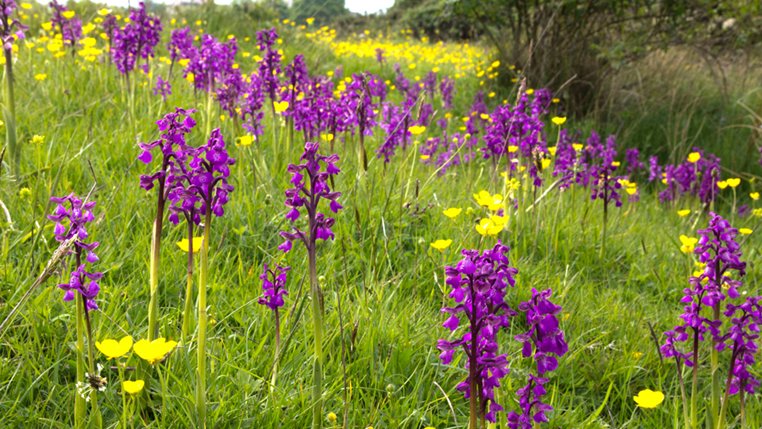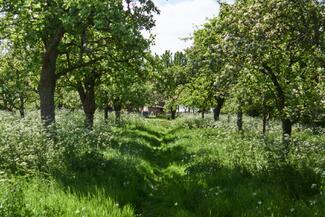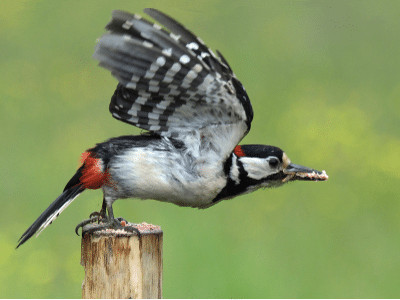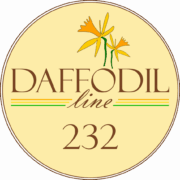View the rolling hills, meadows, woods, orchards and stream-sides from the superb vantage point of the 232 Daffodil Line bus, then alight and step out to explore the beautiful intricacies of the summer landscape.

Geological mixtures of silica-rich sandstone, heavier clay ‘marls’ and pockets of limestone create our soil types and lend their names to some of the places along or nearby the bus route, from Sandford to Marcle and Red Marley. Apparently Herefordshire was under the sea during the Jurassic period, creating unusual limestone from calcified seashells and the effect of seawater reacting with the alkalinity. Hence this land tends to lend itself to those plants preferring neutral to slightly base conditions, those species favouring acid conditions being rarer here.

The traditional land management practices of pastures for mixed livestock and fowls, orchards with grazing, perennial fruit bushes, common land with rights for mixed grazing including ‘pannage’ of pigs and cutting firewood ‘estovers’, coppicing of woodlands for craft-work, firewood and to fuel lime-kilns evolved as sustainable means of co-existing symbiotically with the environment.
Much changed during the Enclosure movement, the origin of agri-capitalism – when the profit motive led the Lords of the Manors to divide up the common land for wool production and gamekeeping – the commoners becoming bereft of their heritage, with hedgerows and fields becoming the dominant features. Intensive agriculture has led to many losses, including eutrophication and soil erosion from ploughing, but look deeply and there are still wild edges and sensitively managed areas that continue to support a wealth of species.
I suggest taking with you an Ordnance Survey 1:25 000 Explorer Map, which details the field boundaries, useful in following footpaths and byways, plus orange-shaded Open Access Areas that often-times demarcate the surviving Commons. A waterproof map case is also an asset, keeping your map folded to display the relevant area. It is possible to order custom OS maps centred on a location of your choice, which saves taking several maps with you. I take photographs whilst out then identify species at home using a selection of trusty tomes (see the references below); those with painted illustrations are pictorially designed to highlight the key identification features, whilst photographic guides give a good representation of the reality ‘in the field’.
The spring-flowering Wild Daffodils will, by June, be difficult to find as their leaves yellow and the seed-heads split, releasing small black-brown seeds. Contrary to the conditions that their gaudy cultivated cousins find themselves living in, these plants are woodland specialists that flower before the canopy closes over, their ephemeral beauty gracing the ancient woods with a sophistication unachievable by the nurseryman. The intellectual property rights so lauded by the garden centre trade have resulted in innumerate inferior imitations (you cannot trade-mark a wild plant), a serious threat now being hybridisation. As flowering plants reproduce by proxy – Bees, other insects, the wind – pollen from garden plants reaches their wild neighbours.

This is also the case with the English Bluebell, the drifts of dainty deep lilac-blue following the daffodil in a fairy parade across the woodland floor and hedgerow verge. Bluebells have a natural propensity to spread,so when hybridised with the Spanish Bluebell they create a vigorous super-weed with little of the original charm, throwing pink, white and pale blue blooms with a simpler and broader corolla of petals. Primulas (especially primroses) and Viola tricolour are also susceptible. I have taken to gradually replacing cultivars in my garden with their wild forebears, with the added benefit of wild forms being safer and more efficacious for use as herbal remedies and additions to salads. This is not to say that introduced plants such as Rosemary have no place here, nor would I be too pleased if the native Bindweed embraced my garden too enthusiastically!
Old orchards are one of my favourite habitats, the trees being cultivars that trouble no-one and a conservation cause in their own right. Mistletoe might abound, but needs some control to avoid their venerable hosts being wind-thrown during stormy weather. With both Green and Great Spotted Woodpeckers making an appearance, Goldfinches pick the seeds of Groundsel and Marsh Thistles as Swifts scream in their revelries of high-speed flight above.
The old, sunken holloway lanes and tracks, often marked on the map as ‘other permissive routes’ give a home to Wild Strawberries, and their delightful relatives with the uninspiring name of Barren Strawberry. These are joined by Wild Basil, actually a type of Calamint, various Sedges and Vetches. Listen out in these isolated country spots for the hurried birdsong of Warblers such as Whitethroats and Blackcaps, with the hedgerows of more open positions lending themselves to Yellowhammers and occasionally the rasping call and fluttering display of bumblebee-like Stonechats. Other diurnal avian encounters might include the handsome Wheatear, and by dusk you may be lucky enough to catch a glimpse of the elusive Barn Owl or witness the display flight of Woodcock. At midnight in the woods, female Glow-worms bejewel the rides to attract the males that fly overhead.
Meadow-lands, cut late in the summer to allow time for wildflowers to set seed, are either ancient or deliberately sown. Their low fertility (the hay being removed annually for many years) allows a diversity of plants to proliferate, sometimes assisted by Yellow Rattle that parasitises grasses. Its relative, Red Bartsia, can be found on tracks and gateways. Here in the open the Knapweed and Scabious are in their element, alongside Ox-eye Daisies, and you may be fortunate enough to find Orchids such as the not-so Common-Spotted or Green-Winged Orchids, angels of the grassland.
As the seasons blend and change, there is always something to be sought and experienced in the rich and varied mosaic of habitats of Herefordshire and Gloucestershire. Yes, there are threats to this fragile beauty, but what better way to protect and cherish this bounty than to reduce traffic and take a sustainable visit on the 232 Daffodil Line?
References
Field Guide to the Wildflowers of Britain, Readers Digest Nature Lovers Library, 1981/1994
Wildflowers of Britain and Northern Europe, Alistair Fitter, Collins New Generation Guide, 1987
Harrap’s WildFlowers, Simon Harrap, Bloomsbury, 2013
Wild Flowers of Britain and Ireland, Marjorie Blamey Richard & Alistair Fitter, Domino Guides, Bloomsbury, 2013
RSPB Handbook of British Birds, Peter Holden and Tim Cleeves, Bloomsbury, 2002 / 2014


Great post Jack, good to read something that is based on real knowledge and experience, not over simplified, but completely accessible and is beautifully written, thank you
This is the world just where we are. We don’t have to travel far to experience it as long as we practise living in the moment and enjoying one day at a time in the beautiful countryside right on our doorstep.